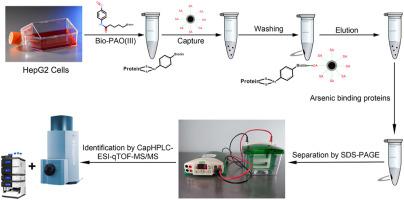Analytica Chimica Acta ( IF 6.2 ) Pub Date : 2021-08-31 , DOI: 10.1016/j.aca.2021.339007 Kai Nan 1 , Man He 1 , Beibei Chen 1 , Bin Hu 1

|
For a deep understanding of arsenic's mutagenicity, carcinogenicity and teratogenicity, the elucidation of arsenic binding proteins in organisms is a necessary prerequisite. Herein, a biotinylated phenylarsenite (Bio-PAO(III)) probe was synthesized for in situ binding to arsenic binding proteins in HepG2 cells. The Bio-PAO(III)-arsenic binding proteins complexes were captured by the prepared streptavidin-magnetic beads (SA-MBs) by specific interaction of biotin-SA. After magnetic separation, the arsenic binding proteins in the eluent was separated by sodium dodecyl sulfate-polyacrylamide - gel electrophoresis, and the in-gel tryptic digested protein bands were subjected to capillary high performance liquid chromatography coupled with electrospray ionization mass spectrometry analysis. 32 kinds of arsenic binding proteins were identified in HepG2 cells, which could be divided into three groups, structure proteins, enzymes related with tricarboxylic acid cycle and fatty synthesis and transcriptional regulator. Poly [ADP-ribose] polymerase 1 and general transcription factor IIH subunit 1 were identified to bind with arsenicals, which may affect the process of nucleotide excision repair in HepG2 cells.
中文翻译:

基于生物素化苯亚砷酸盐探针分析 HepG2 细胞中的砷结合蛋白
要深入了解砷的致突变性、致癌性和致畸性,阐明生物体内的砷结合蛋白是必要的先决条件。在此,原位合成了生物素化苯亚砷酸盐(Bio-PAO(III))探针。与 HepG2 细胞中的砷结合蛋白结合。Bio-PAO(III)-砷结合蛋白复合物通过生物素-SA 的特异性相互作用被制备的链霉亲和素-磁珠 (SA-MBs) 捕获。磁分离后,洗脱液中的砷结合蛋白通过十二烷基硫酸钠-聚丙烯酰胺-凝胶电泳分离,凝胶内胰蛋白酶消化的蛋白条带进行毛细管高效液相色谱-电喷雾电离质谱分析。在HepG2细胞中鉴定出32种砷结合蛋白,可分为结构蛋白、三羧酸循环和脂肪合成相关酶以及转录调节蛋白三类。



























 京公网安备 11010802027423号
京公网安备 11010802027423号